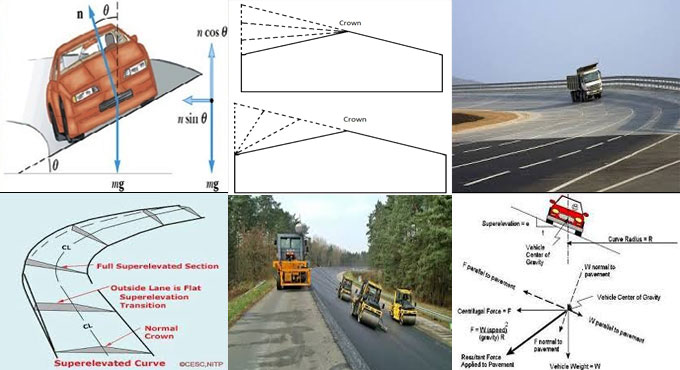
Superelevation of Roads - What, Why and How

What is Superelevation?
More commonly known as the Banking or Cant, the Superelevation of a bend in a road is officially defined as ?The inward transverse inclination which is provided to the cross-section of the pavement of road at the horizontally curved portion of the roads.?
Basically, it means how much the road is tilted inwards to the bend of the road. It is constructed mostly at the bends in highways and freeways where cars move at a high speed. You can also see this in racetracks.
When vehicles moving at high speeds need to turn while maintaining the speed, due to the centrifugal force they can skid towards the outside of the bend and even flip over, thus causing massive accidents. If the road is built tilted inwards to the bend (i.e. making an embankment) the vehicles would also ?bank? towards the bend. The force then pushes them harder onto the pavement, instead of pushing then sideways. This transverse slope of the road is called the superelevation of the bend in question.
Why superelevation is needed?
There are various reasons why you must provide superelevation at the bends of roads, the primary of which is safety. Here we will enumerate all the reasons.
1. To counteract the effect of the centrifugal force acting on moving vehicles in a bend.
2. To evenly distribute the load of the vehicles on the road in a bend.
3. To prevent fast-moving vehicles from skidding or overturning when traversing an arc.
4. To reduce maintenance costs for the road damages due to instability issues.
5. To ensure safe and smooth movement of speeding vehicles and passengers within them.
How to calculate superelevation of a road or bend?
Let?s assume a vehicle of W weight is moving at a high speed along an arc on a road. The road is circular horizontally curved at that point of R radius, and the vehicle?s speed is V.
So, the centrifugal force acting on the vehicle at that point would be
P = (W.V2/gR)
Here g is, of course, gravitational acceleration.
Now, the friction which is developed between the wheel of the vehicle and the pavement acting transversely along the pavement surface towards the center of the curve. Furthermore, the centrifugal force is opposed by the corresponding value of the friction developed and by a component of the force of gravity due to the Superelevation is provided.
Now that we know all about the forces acting on the vehicle, we can calculate the superelevation at that point of the road.
Formula of Superelevation
The superelevation is provided on the road by the following formula
e + f = (V2 / 127 R)
R = 0.036 V2
Where,
e = rate of super elevation
f = design coefficient of lateral friction= 0.15
This may change depending upon the road type, weather condition etc.
g = acceleration due to gravity= 9.81 m/s2
R = radius of the curve
We can also figure out the angle of superelevation by using the above math.
Points to consider about superelevation
Now, we should remember that we don?t always need to provide superelevation. For example, where the road is curving in a very wide arc, and/or the vehicles would move quite slowly. We can calculate this by figuring out if the friction is way too big to be overwhelmed by the possible centrifugal force.
While the above calculation is quite fine for standard vehicles on the road, but if we expect heavily loaded, tall vehicles moving through the road, we need to take the center of gravity of those vehicles into account as well. Otherwise, if they pass through a high banking curve at a relatively lower speed (which they often have to because of the huge or oversize load), they might simply keel off.


